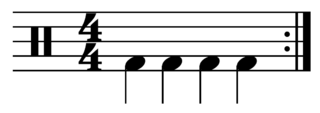 W
WDisco is a genre of dance music and a subculture that emerged in the 1970s from the United States' urban nightlife scene. Its sound is typified by four-on-the-floor beats, syncopated basslines, string sections, horns, electric piano, synthesizers, and electric rhythm guitars.
 W
WA disco ball is a roughly spherical object that reflects light directed at it in many directions, producing a complex display. Its surface consists of hundreds or thousands of facets, nearly all of approximately the same shape and size, and each having a mirrored surface. Usually it is mounted well above the heads of the people present, suspended from a device that causes it to rotate steadily on a vertical axis and illuminated by spotlights, so that stationary viewers experience beams of light flashing over them, and see myriad spots of light spinning around the walls of the room.
 W
WBeatmatching or pitch cue is a disc jockey technique of pitch shifting or timestretching an upcoming track to match its tempo to that of the currently playing track, and to adjust them such that the beats are synchronised — e.g. the kicks and snares in two house records hit at the same time when both records are played simultaneously. Beatmatching is a component of beatmixing which employs beatmatching combined with equalization, attention to phrasing and track selection in an attempt to make a single mix that flows together and has a good structure.
 W
WClub drugs, also called rave drugs, or party drugs are a loosely defined category of recreational drugs which are associated with discothèques in the 1970s and nightclubs, dance clubs, electronic dance music (EDM) parties, and raves in the 1980s to today. Unlike many other categories, such as opiates and benzodiazepines, which are established according to pharmaceutical or chemical properties, club drugs are a "category of convenience", in which drugs are included due to the locations they are consumed and/or where the user goes while under the influence of the drugs. Club drugs are generally used by adolescents and young adults. This group of drugs is also called "designer drugs", as most are synthesized in a chemical lab rather than being sourced from plants or opiates.
 W
WA disc jockey, more commonly abbreviated as DJ, is a person who plays recorded music for an audience. Types of DJs include radio DJs, club DJs, mobile DJs, and turntablists. Originally, the "disc" in "disc jockey" referred to shellac and later vinyl records, but nowadays DJ is used as an all-encompassing term to also describe persons who mix music from other recording media such as cassettes, CDs or digital audio files on a CDJ, controller, or even a laptop. DJs may adopt the title "DJ" in front of their real names, adopted pseudonyms, or stage names.
 W
WStobie the Disco Cuttlefish was the mascot of the 2014 Adelaide Fringe in South Australia. Its design was inspired by the cephalopod species Sepia apama, the Giant Australian Cuttlefish. Stobie was a 13 metre long mechanised parade float which featured blinking eyes, waving tentacles and an elaborate sound, light and dance show. It made appearances each Saturday night during the festival, accompanied by a professional dance troupe which performed a set routine. This was followed by an original dance called 'The Cuttlefish' during which crowd participation was invited. Stobie also played a pre-recorded soundtrack of disco hits including a megamix of Stayin' Alive, Billie Jean, You Should be Dancing and Le Freak. The opening set routine was performed to the theme-song from the 1980 dance movie, Fame.
 W
WDorian Gray was a popular nightclub in the 1980s and 1990s, located in Frankfurt Airport in Frankfurt am Main, Germany. The owners, Gerd Schüler and Michael Presinger, opened the club on 8 November 1978. The idea was to offer similar events as New York's famous club Studio 54. This was one of the largest nightclubs in Germany at that time. The design of the nightclub cost more than 2.5million Deutsche Marks and laid the cornerstone for the successful Airport club brand. The name of the club comes from Oscar Wilde's novel The Picture of Dorian Gray.
 W
WFour-on-the-floor is a rhythm pattern used primarily in disco and electronic dance music. It is a steady, uniformly accented beat in 4/4 time in which the bass drum is hit on every beat in common time. This was popularized in the disco music of the 1970s and the term four-on-the-floor was widely used in that era: it originated with the pedal-operated, drum-kit bass drum. Earl Young is seen as the inventor of the disco style of rock drumming, as he was the first to make extensive and distinctive use of the hi-hat cymbal throughout the playing time of an R&B recording.
 W
WAn illuminated dance floor, LED dance floor or disco dance floor is a floor with panels or tiles that light up with different colours. They are used for dance. They were popularised for disco by the 1977 film Saturday Night Fever, which had gotten its inspiration from a floor that director John Badham had seen at "The Club", a private supper club in Birmingham, Alabama.
 W
WA roller disco is a discothèque or skating rink where all the dancers wear roller skates of some kind. The music played is modern and easily danceable, historically disco but in modern times including almost any form of dance, pop or rock music.
 W
WStudio 54 is a Broadway theatre and a former disco nightclub located on 54th Street in Midtown Manhattan, New York City. The building opened in 1927 as the Gallo Opera House. It operated as an entertainment venue under various names until 1942, when CBS began using it as a radio and television studio dubbed Studio 52.
 W
WWaacking is a form of street dance created in the LGBT clubs of Los Angeles during the 1970s disco era. The style is typically done to 70s disco music and is mainly distinguishable by its rotational arm movements, posing and emphasis on expressiveness.